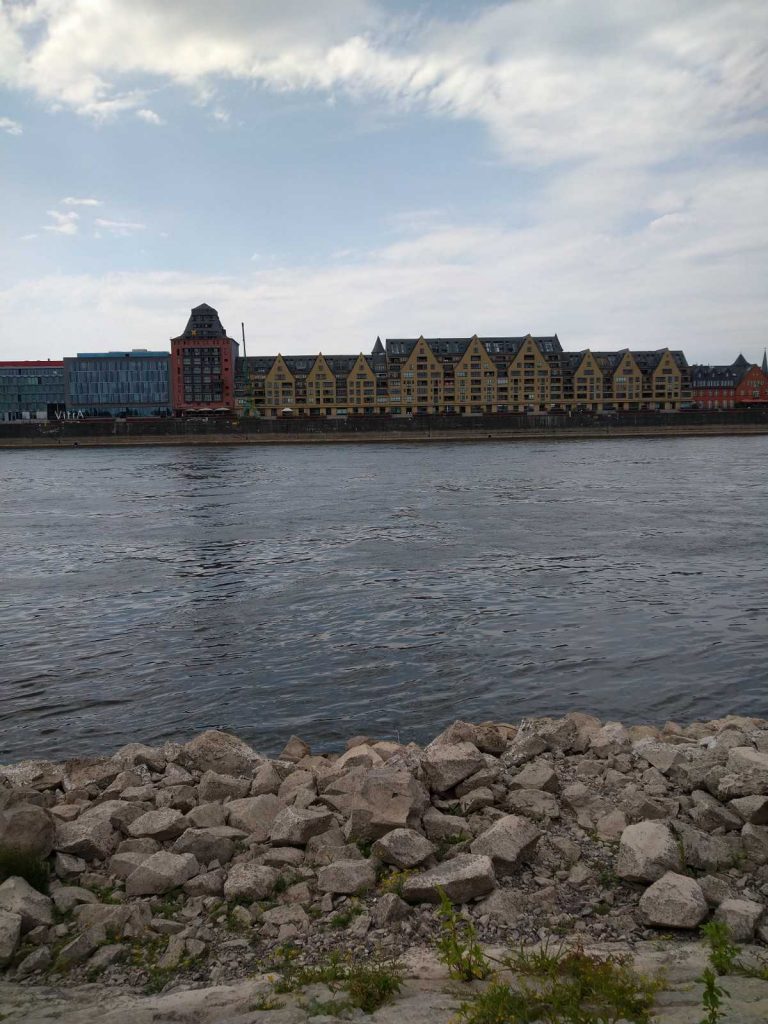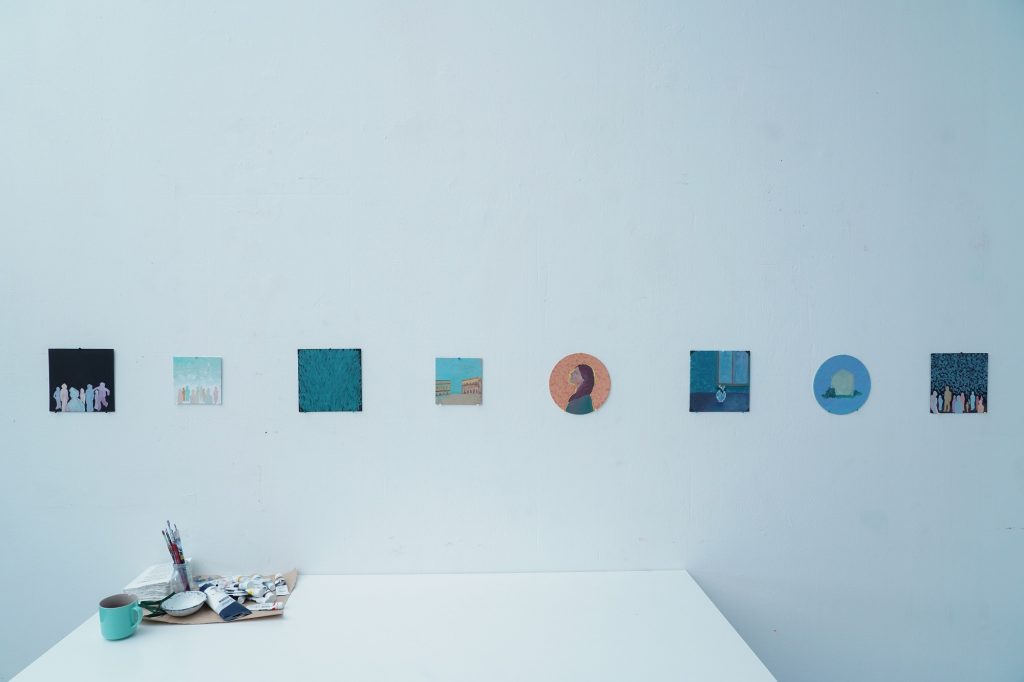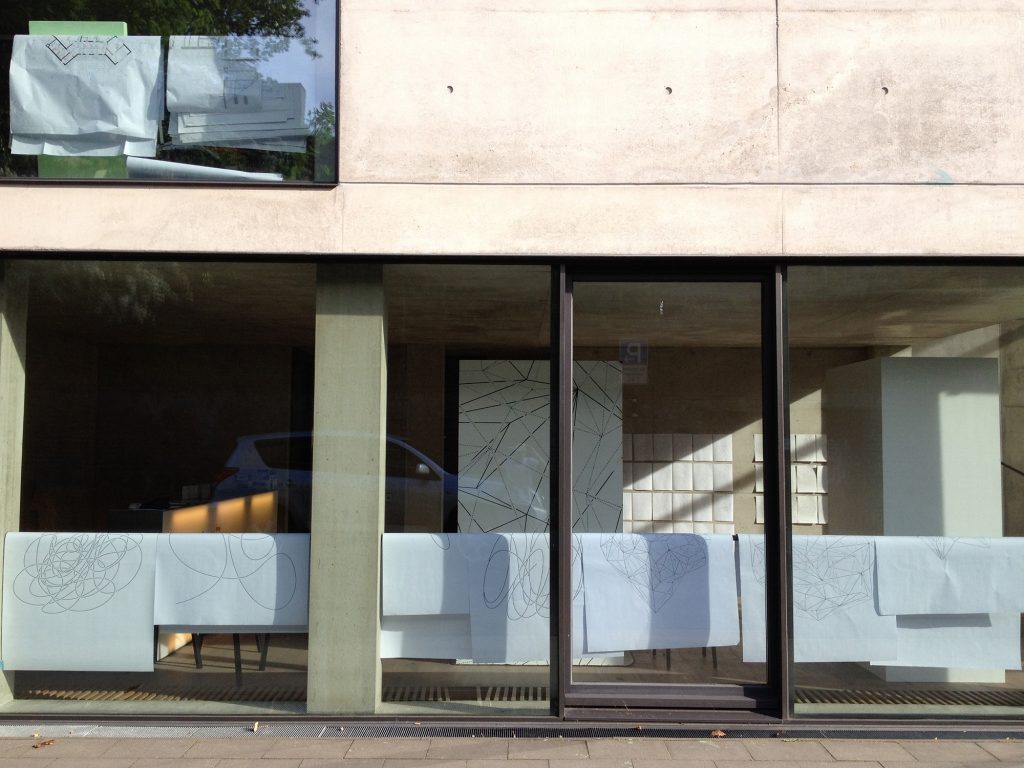

On January 21, 2023, a feedback session was held inviting Alina Zidanova, who spent two months at Quartier am Hafen in Cologne, Germany, as part of Kyoto Art Center’s Artist in Residence (AIR) program. The following is a report on the event.
Since 2016, as part of its AIR program, Kyoto Art Center has been running an exchange program with its partner, Quartier am Hafen in Köln, Germany. Alina Zhdanova was selected for the program in 2022, as the artist representing Kyoto through the open call. Her two months residence was from 1st June to 1st August in Köln.
In this feedback session, Zhdanova shared her creative process and resulting works in Köln. We invited Soshi Matsunobe, as a guest, who had also been an artist-in-residence in Köln under the former program called KYOTO.KÖLN in 2012. The session was facilitated by Ryuichi Tani, program director of Kyoto Art Center.

Walk along the Rhine
Quartier am Hafen is the largest scale artist studio in Köln with 82 studios located along the Rhine, 30-40 minutes away from the center of the city. Since its start in 2010, with the support of Köln city, it has been supporting Köln based artists, as well as running the international AIR program.
During her stay, Zhdanova was provided with a bright studio. She enjoyed the freshness of the room as a living space. However, as a video artist creating animation, sometimes she had difficulties controlling the light because in summer it was still bright until 9pm.
Zhdanova presented her work twice during her stay. The first was a co-presentation with another artist who was holding an exhibition at Quartier am Hafen at that time, and the second was held as an open studio. Also she went to art festivals like Berlin Biennale and “documenta fifteen”, and actively traveled around Germany and neighboring countries. During this time in Germany, as a government measure for the energy price rises, a travel pass ticket called “the 9 Euro Ticket” was on sale for just 9 euros (about 1,300yen) which allowed people to use all public transport in Germany (except long-distance trains or buses between cities) for a month. She made full use of this ticket to travel all over Germany. In any residence program, there is always the potential for the creative process to be influenced by the current social situation. In Zhdanova’s case, this had both a positive and negative effect on her work.
Zhdanova was born in Russia, and grew up in Japan. Currently, she is based in Kyoto, researching, and creating work on the theme of memory and oblivion. She believes that she can reveal society and the world by gathering her own memories and forgotten memories, and overlapping or juxtaposing them. In 2021, she went to Russia and conducted research to trace her own roots. Based on this research, she wondered what would happen if she applied her concept to other people. Would it be possible to create artwork with other people’s memories? This became the focus of her work on this residence program.
She set “encounters” as the theme of her residence, and aimed to go to different places, putting an emphasis on meeting many people to talk to and interview in order to collect their memories. Also, as “things I always do when I’m abroad”, she practiced finding materials in location, and trying to do something with them.
As the reason to choose Köln, Zhdanova explained that she was “interested in Germany which has the history of division and integration, rather than Köln itself.” In preparation for her artist in residence in Germany, she studied German in Japan. “It was great to have this language ability to start my life and interviews on a basic level”. Zhdanova talked about the importance of her preparations. Matsunobe who had many experiences of attending residence programs in Köln and other places, agreed about the importance of learning local languages, as he had experienced problems because he could not understand the local language.
As her impression of Köln, Zhdanova said “Especially in Köln, many immigrants gathered in the town. As a result, I had the chance to talk to more people from diverse backgrounds than in Japan. I felt Köln may have an easy environment for immigrants to live in, and the city has tolerance for people from outside more than other German cities.” Although one of the strengths of residency is that you can jump into a society because you don’t know much about it, another important aspect is that you can realize the local characteristic of a place or face yourself through living there for a while and encountering people.
During her residency, Zhdanova interviewed people from different backgrounds. Some were introduced to her by the residency institutions, others she found by herself by approaching people in parks in the city (she was successful 60% of the time). In the end, she managed to interview and gather the memories of nearly 20 people. In the interviews, she asked about their first memories and childhood homes, and recorded their reactions and answers. After listening to their memories, especially witnessing the reality that many immigrants and refugees from Russia and Ukraine were flowing into European countries, she realized that she herself was an immigrant who was born and raised in Japan. This realization gave her a new theme “migration”.
The talk shifted to the topic of migration and mobility of people after Matsunobe talked about his recent residency in Sapporo Tenjinyama Art Studio. As a child, Zhdanova said that she “spent time at school or with friends without thinking I am a foreigner”. It was in her grade 3 or 4 she became aware of her own roots. Playing with her hair in the bath, she recognized that she had “blond hair”, and realized “Oh, I’m not Japanese. I’m a foreigner.” When she moved to Kyoto, she was exposed to more occasions when people saw her as a foreigner. “While realizing I am a migrant immigrated to Japan, and a foreigner, and gradually internalizing it, I started being interested in migration and migrants” she said. And every time she conducted interviews in Köln by introducing herself, repeating her birth, born in Russia and brought up in Japan, she became more aware of her own roots and thought about migration.
After Zhdanova applied for the residency, the Russian invasion of Ukraine started. She did not know who or what to believe amidst information from the Japanese and Russian media. She traveled to Köln with this confused feeling. In Köln, she could see and talk to many people who fled Russia and Ukraine. Some were there as short-term residents, others were students or had already found jobs there. It was as if she was witnessing the moment of birth of migrants or moments people migrate, and was projecting them onto her own upbringing; born in Russia and raised in Japan. She said “To be honest, the issues of migrants or refugees, or the topic between Russia and Ukraine were more visible there for me compared to when I was in Japan, as I could see those people in front of me, it was easier to face those issues.”
Towards the end of her stay, on 29th and 30th July, an open studio was held for her final presentation. On the first day, it was open from 9pm as it started to get dark, until midnight, and on the second day, from 1pm to 6pm. On the 1st floor Zhdanova projected an animation piece (on the second day, she played the same piece on the monitor), on the second floor, she exhibited a photo album and other materials she had bought in a recycle shop in Köln. This photo album was found by chance. It was “starting with the photos of a wedding on 26th May 1950, followed by a honeymoon, birth of a child, birthday parties, which were 20 years worth of photos. I didn’t know who they belonged to.” It recorded the memories of one German family’s life stages.



Open Studio
The animation piece on the first floor was projected on a light-transmitting cloth painted with white paint. After returning to Japan, this cloth was modified and exhibited in an exhibition at Zuiun-an in Kyoto in September. It was further developed and exhibited at Marugame Genichiro-Inokuma Museum of Contemporary Art in November together with the voices of the interviewees talking about their memories.
In the next section, Matsunobe looked back on his experience in Köln, Latvia and Paris, and talked about interesting differences in the creative process and style between Zhdanova and himself. Matsunobe said “As I create my work using universal aspects, though I go to various places during my stay, I don’t especially focus on involving others in my work. I tend to think about what I can do while I just live there.” And he describes AIR as “an improvisational collaboration with artists you meet at the residency, the process of clashing with each other’s opinion and destroying and recreating things is the real thrill of the residency and an important experience.”

Matsunobe Soshi’s view of his artist in aesidency at SCHILLING ARCHITEKTEN, Köln
For Zhdanova “it was a fruitful residency because I worked with the theme of encountering people, knowing, traveling, and experimenting. There were times I couldn’t work because I was too tired from traveling so much, but I think I could return home with material that would lead to later work. More than anything, I am happy that I could meet many artworks and artists.”, she reflected, and added “It was a time for me to face myself. I had a lot of things to think about, including the issues between Russia and Ukraine, especially after I started to deal with the theme of memory in my work.” She shared her realization which she gained through her own experience in the residency, talked about her future plans in residencies in other locations.
As for Matsunobe’s future prospects, with his past experiences in residencies, he said “I think it is more important to set up my own studio and try to invite people to work there.”
After hearing their talk, Tani said “While social tensions grow, it’s becoming more and more difficult to talk about political topics. It is important for people from different backgrounds to have their own experience, and to have a place where they can bring back what they have encountered and share them with others.” Tani also showed his attitude to support the different ways of using time and provide different options of time management, and accommodate the wide range of viewpoints in AIR program. As a program organizer, Tani expressed with enthusiasm that he “would like many artists to participate in the residence program, and in order to create a new network from their experiences, I would like to develop relationships with various cultural institutions in different locations.”
Text written and edit by Mizuno Noriko
Zhdanova Alina
Born in Russia, raised in Japan. Video artist and independent curator. Research of the Oblivion in Personality Development in graduate school. Using the own memories and roots as a motif, create works that seem to dialogue with the viewer’s memories.
Zhdanova has presented her works at film festivals and exhibitions in Japan and overseas. She awarded Grand Prize, The 2nd CAF AWARD as well as Grand Prix and Goethe-Institut Villa Kamogawa International Exchange Prix, Kyoto Art for Tomorrow 2021 –Selected Up-and-coming Artists’ Exhibition”, The Museum of Kyoto. Her first curating exhibition was “Symptoms -Four thoughts and physicality-” in 2021.
https://www.zhdalina.com/
Matsunobe Soshi
Born in 1988, Kumamoto. He is based in Kyoto. Matsunobe’s work is about the “ground” in terms of figures and grounds and represents an abstract concept outside our consciousness in our daily lives. In recent years, he has expanded his activities by collaborating with performers and renovating residences.
https://matsunobe.net/index.html
Quartier am Hafen
Quartier am Hafen is a large-scale artists studio located along the Rhine River in Cologne, Germany. Since its establishment in 2010, with the cooperation of the city of Cologne, Quartier am Hafen has aimed to become a creative center for artists of various genres to work. In addition to supporting artists based in Cologne, it also offers international artist-in-residence programs.
https://qah.koeln/de/
Feedback Session of Artist-in-Residence Program 2022/2023 Exchange Programs:Quartier am Hafen
Date: January 21, 2023
Venue: Kyoto Art Center
Presenter: Zhdanova Alina
Guest: Matsunobe Soshi
Moderator: Tani Ryuichi, Kyoto Art Center Program Director
https://www.kac.or.jp/events/33180/
2024.7.9Acasă la Hundorf Residency JournalArtist : Miyake Suzuko
2023.5.14AIR and I, 09 : Mentoring Artists for Women’s Art (MAWA) Residence Report